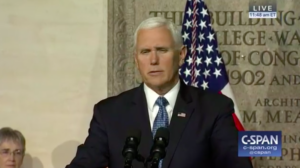Here’s a rundown of the latest Space Force developments

This article was first published in the SN Military.Space newsletter. If you would like to get our news and insights for national security space professionals every Tuesday, sign up below.
BIG PUSH BY VP PENCE At the National Space Council meeting last week, Vice President Mike Pence made an impassioned case for the establishment of a Space Force. But no matter how much President Trump wants it, congressional authorization by law is required to form a new military branch. Pence said Trump will work tirelessly to make sure the legislative language to create a Space Force makes it into the National Defense Authorization Act for Fiscal Year 2020. The council endorsed the Pentagon’s recommendations and a policy directive is being drafted for Trump’s signature.
Stephen Kitay, deputy assistant secretary of defense for space policy, also offered a strong endorsement for the president’s plan. “This will be a force that is focused on space and the space needs of our combatant commands,” he said at a space conference in Huntsville, Alabama. “This force will train and grow national security space professionals and will develop the doctrine and capabilities needed to enable the joint warfighter and ensure that we can fight and win should warfare extend into space.”
Kitay, formerly a senior staff member on the House Armed Services Committee’s strategic forces subcommittee, said that the administration is “working to make sure that we educate Congress and the American people more about the serious nature of those threats and the importance of space.”
On the upcoming debate on Capitol Hill: “I think it’s going to be an exciting and interesting discussion.”
PENTAGON PURSUING SPACE DEVELOPMENT AGENCY Deputy Defense Secretary Patrick Shanahan said his primary focus as he drafts a Space Force legislative proposal is on how the military will acquire cutting-edge space technologies. He is pressing forward with the establishment of a Space Development Agency to take the lead in acquisitions of new systems and also to help to consolidate duplicative space projects pursued by individual services. “How do you align the department so we don’t solve the same problem multiple times?” he asked.
All the services use space, and some investment should be shared, he said. The biggest challenge here is “not the technology but how do you get DoD aligned?”
Shanahan’s thinking appears to be influenced by conversations with Army Futures Command’s Lt. Gen. John Murray. Ground forces are the military’s biggest users of space services like communications, timing, navigation and early warning of missile launches. Shanahan said the Army should have some say in the “space architecture,” such as how future constellations are designed and constructed. “If the Army is first in developing a component of our space architecture, how do we get everybody to hold hands and say the Air Force is going to adopt the same thing?”
WARNING ABOUT SPACE FORCE A contrarian view on the Space Force comes from Dan Grazier, military fellow at the Center for Defense Information at the Project on Government Oversight. He predicts that “if we create this new bureaucracy, its first goal is going to be to protect its own existence. A secondary goal will be to justify its existence. Only after that it’ll start focusing on the mission at hand. And even then, the mission at hand is going to be disconnected from the operations of the other services.”
Drawing on his research as a military historian, Grazier said the establishment of a new service is likely to fuel rivalries, which could be counterproductive, he argues. The military already struggles to deliver space capabilities to forces in the field because the organizations that worry about space are not responsible for the equipment that is needed on the ground. The Air Force buys satellites but the Army has to buy the radios that talk to the satellites. “We see this now,” says Grazier. “An independent service dedicated to space will quickly forge its own bureaucratic path separate from the existing military forces. This will provoke more inter-service rivalries and distract from rather than contribute to future military success.”
from SpaceNews.com https://ift.tt/2RqMLrf



Comments
Post a Comment